内蒙古中部二叠纪额布图岩体的橄榄石成分特征及其对辉石岩地幔源区的指示
暴宏天, 王 焰, 曹勇华, 魏 博, 3
内蒙古中部二叠纪额布图岩体的橄榄石成分特征及其对辉石岩地幔源区的指示
暴宏天1, 2, 王 焰1, 3*, 曹勇华1, 魏 博1, 3
(1.中国科学院 广州地球化学研究所, 矿物学与成矿学重点实验室, 广东 广州 510640; 2.中国科学院大学, 北京 100049; 3.广东省矿物物理与材料研究开发重点实验室, 广东 广州 510640)
内蒙古中部的额布图超镁铁质岩体位于中亚造山带与华北克拉通北缘的碰撞拼贴带内, 发育铜镍硫化物矿化。该岩体主要由橄榄斜方辉石岩和斜方辉石岩组成, 橄榄斜方辉石岩中橄榄石含量~15%, 斜方辉石岩中橄榄石含量<5%, 两种岩石中橄榄石的Fo值介于83~87之间。在Fo值相同时, 与橄榄岩地幔部分熔融熔体中结晶的橄榄石相比, 额布图岩体中的橄榄石具有较低的Mn含量, 指示其母岩浆可能不是橄榄岩地幔的熔融产物。同时, 该岩体的橄榄石具有较低的Mn/Zn和Mn/Fe值、较高的Zn/Fe值, 与来源于典型辉石岩地幔的Mwenezi和Tuli玄武岩中橄榄石斑晶的相应比值一致。因此, 额布图岩体的地幔源区可能以辉石岩为主。同时, 该岩体中橄榄石的Ca含量较低、Li含量较高指示其源区可能经历了俯冲流体的改造。因此, 额布图岩体地幔源区中的辉石岩组分可能是当古亚洲洋板片向南俯冲至华北克拉通之下时, 来自俯冲板片的流体/挥发分进入上覆地幔楔, 造成先存于地幔中的古老下地壳组分发生熔融并交代周围的地幔橄榄岩形成的。
橄榄石; 辉石岩地幔; 额布图超镁铁质岩体; 中亚造山带
0 引 言
随着赋含铜镍硫化物矿床(化)的镁铁‒超镁铁质岩体在汇聚板块边缘不断被发现, 与俯冲作用有关的含矿镁铁‒超镁铁质岩体的成因受到了广泛关注。中亚造山带自古生代以来发育了一系列赋含铜镍硫化物矿床(化)的岩体, 构成了世界上最长的汇聚板块边缘铜镍硫化物成矿带。在我国境内的中亚造山带发育大量含矿岩体, 包括菁布拉克、喀拉通克、图拉尔根、黑山、黄山东、黄山西、黄山南、香山、坡北、白石泉、葫芦、天宇、红旗岭7号、漂河川4号和额布图岩体等。这些岩体中岩石的微量元素组成普遍具有大离子亲石元素富集及高场强元素亏损的岛弧岩浆特征, 可能与其地幔源区受到来自俯冲板片的流体/挥发分交代作用有关(Zhou et al., 2004; Song et al., 2011, 2013; Li et al., 2012; Xie et al., 2012)。
有学者认为, 俯冲板片释放的流体/挥发分进入地幔楔后, 有可能导致地幔中的再循环地壳组分发生熔融并交代其周围的橄榄岩地幔, 从而产生辉石岩地幔组分(Gao et al., 2004, 2008; Liu et al., 2005)。而地幔中的再循环地壳组分多以榴辉岩形式存在(Stracke, 2012; Hofmann, 2014)。相比地幔橄榄岩, 榴辉岩的固相线温度较低(Yaxley and Green, 1998; Rapp et al., 1999; Kogiso et al., 2003)。当软流圈地幔岩浆上涌或有水加入时, 均会造成榴辉岩组分熔融, 如果其与周围的地幔橄榄岩反应, 则形成相对富硅的地幔辉石岩(Hirschmann et al., 2003; Gao et al., 2004, 2008; Liu et al., 2005; Sobolev et al., 2005)。
橄榄石是幔源基性岩浆中较早结晶的矿物, 其成分可能记录了初始岩浆的特征。Ni和Mn在橄榄石与熔体之间的分配系数分别为7.37~11.9(Wang and Gaetani, 2008)和0.89(Foley et al., 2013), 它们在辉石与熔体中的分配系数分别为2.44~3.78(Le Roux et al., 2011)和1 (Foley et al., 2013)。因此, 相比橄榄岩地幔, 在同等部分熔融程度条件下, 辉石岩地幔部分熔融产生的熔体会具有较高的Si和Ni含量, 以及较低的Mn含量, 从辉石岩地幔熔体中结晶的橄榄石通常也具有高Ni、低Mn的特征(Sobolev et al., 2005, 2007; Herzberg and Asimow, 2008; De Hoog et al., 2010; Herzberg, 2011; Foley et al., 2013; Howarth and Harris, 2017)。另外, 在橄榄石‒硅酸盐熔体之间分配系数相似的元素对, 如Mn-Fe、Ni-Mg、Zn-Fe、Mn-Zn等, 其在橄榄石中的比值基本不受岩浆分离结晶作用的影响, 可以近似代表其在硅酸盐熔体中的初始比值(Sobolev et al., 2007; Le Roux et al., 2010; Herzberg, 2011; Mallik and Dasgupta, 2012; Søager et al., 2015), 因此橄榄石中的这些元素比值可用来探讨镁铁‒超镁铁质岩体的地幔源区特征。与橄榄岩地幔部分熔融熔体中结晶的橄榄石相比, 从辉石岩地幔部分熔融产生的熔体中结晶的橄榄石可能具有较高的Ni/Mg和Zn/Fe值, 以及较低的Mn/Fe和Mn/Zn值(Sobolev et al., 2007; Le Roux et al., 2010; Howarth and Harris, 2017)。因此, 镁铁‒超镁铁质岩体中橄榄石的成分特征可为探讨其地幔源区组成提供重要依据。
额布图岩体位于内蒙古中部索伦缝合带(图1), 具铜镍硫化物矿化, 矿石的Ni品位为0.3%~2%, Ni金属量约1 Mt(Peng et al., 2013)。岩体的形成与古亚洲洋俯冲作用有关, 其母岩浆具高Mg和高Si的特征, 与玻安质岩浆的成分类似(Peng et al., 2013)。其地幔源区是否存在辉石岩组分、辉石岩组分对镍矿化是否有贡献, 是两个值得探讨的问题。本文通过分析额布图岩体中橄榄石的成分特征, 探讨其地幔源区中辉石岩组分的贡献, 以及辉石岩地幔组分的存在与铜镍硫化物矿化的关系。
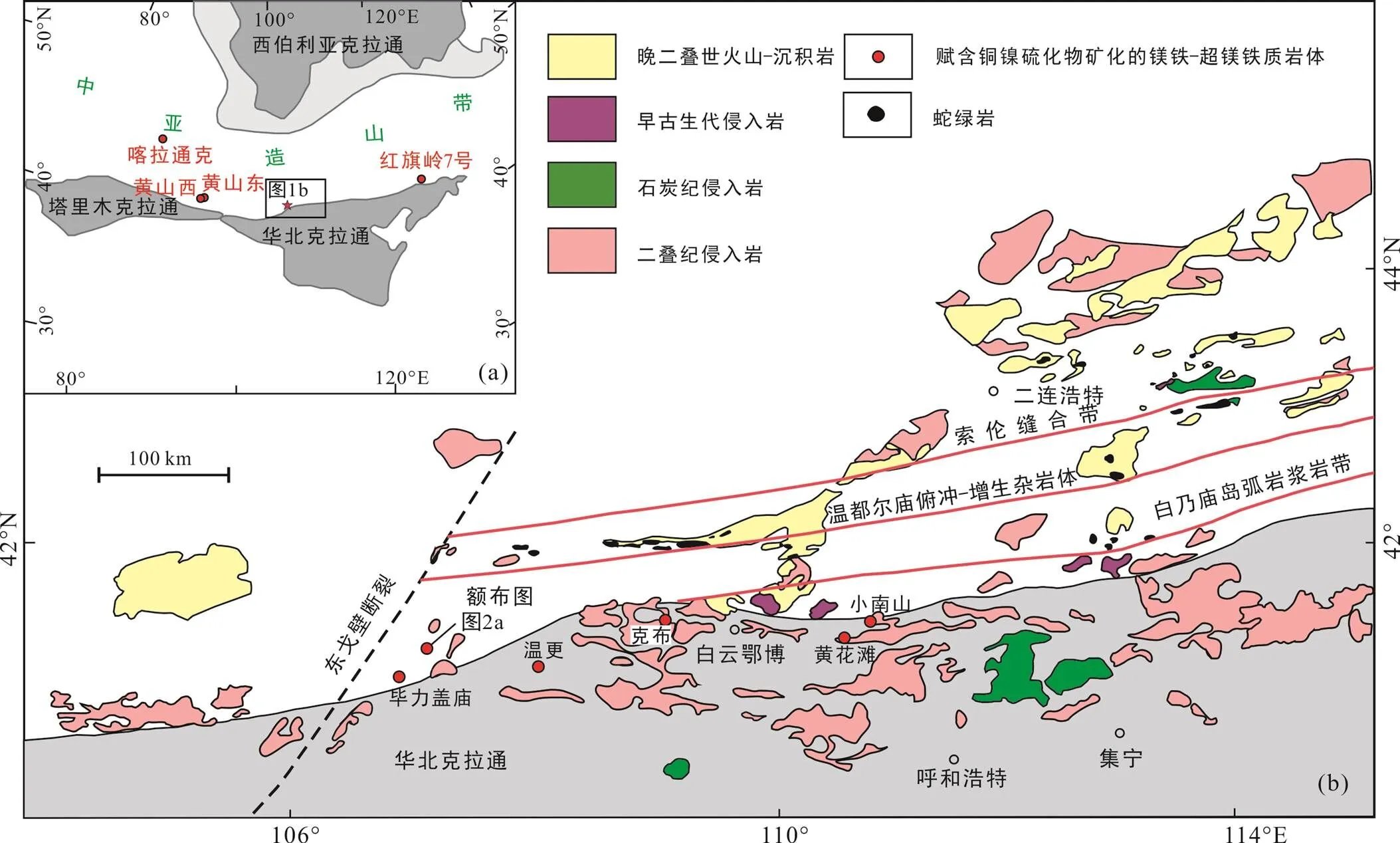
图1 中亚造山带的构造位置(a, 据Jahn, 2004)和内蒙古中部区域地质简图(b, 据Jian et al., 2008)
1 地质背景和岩体特征
中亚造山带位于西伯利亚板块、华北板块和塔里木板块之间, 其东西向延伸超过7000 km, 是全球范围内显生宙地壳增生和改造最显著的地区, 同时也是全球矿产资源潜力最大的地区之一(Xiao et al., 2008)。中亚造山带是古亚洲洋在新元古代至晚古生代期间经历了打开、消减和闭合形成的巨型缝合带, 该带由一系列微陆块、岛弧、蛇绿岩和火山岩组成(Jahn, 2004; Windley et al., 2007; Xiao et al., 2009)。自古生代以来, 在中亚造山带我国境内部分发育了大量的镁铁‒超镁铁质岩体, 其中赋含铜镍硫化物矿化的岩体主要形成于早二叠世‒晚三叠世, 且主要集中于中亚造山带东段和西段, 其中大型含矿岩体主要包括红旗岭7号、黄山西、黄山东和喀拉通克岩体(Song and Li, 2009; Gao and Zhou, 2013; Sun et al., 2013; Wei et al., 2013)(图1a), 中‒小型含矿岩体主要包括葫芦、白石泉、天宇和红旗岭1号岩体等(孙涛等, 2010; Tang et al., 2011, 2013; 吕林素等, 2012)。在中亚造山带中段的内蒙古中部地区, 镁铁‒超镁铁质岩体呈带状分布, 包括小南山、黄花滩、克布、温根、特颇格日图、达布逊、额布图岩体等(江思宏等, 2003; 李鹏等, 2013; 党智财等, 2014; 李志丹等, 2015; 赵泽霖等, 2016)。这些岩体大多规模较小、且矿化程度低, 相对而言, 额布图岩体是其中矿化程度较高的一个。
内蒙古中部地区自北向南由索伦缝合带、温都尔庙俯冲‒增生杂岩体和白乃庙岛弧岩浆岩带三个东西向延伸的构造单元组成, 白乃庙岛弧岩浆岩带南部与华北克拉通北缘相接(Xiao et al., 2003)。区内主要出露晚二叠世火山‒沉积岩, 石炭纪侵入岩零星出露在索伦缝合带内, 二叠纪侵入岩在索伦缝合带和白乃庙岛弧岩浆岩带内较发育, 零星发育于温都尔庙俯冲‒增生杂岩体内, 早古生代侵入岩主要发育在白乃庙岛弧岩浆岩带中。索伦缝合带中还发育大量蛇绿岩, 普遍认为其可能代表了古亚洲洋最终闭合的位置(Xiao et al., 2003; Jian et al., 2008; Chen et al., 2009; Eizenhöfer et al., 2014)(图1b)。
额布图岩体位于白乃庙岩浆岩带西侧, 平面上近似呈纺锤状, 长约200 m, 宽约100 m (图2a)。钻孔数据显示, 岩体在纵剖面上呈碗状, 向下延伸约200 m(图2b), 直接围岩为中元古界宝音图组变火山‒沉积岩。岩体上部以斜方辉石岩为主, 下部以橄榄斜方辉石岩为主。上部的斜方辉石岩平均厚度约60 m,其顶部5~30 m已风化为氧化带, 橄榄斜方辉石岩的平均厚度约100 m。斜方辉石岩的锆石U-Pb年龄为294.2±2.7 Ma(Peng et al., 2013)。两种岩性均发育浸染状矿化(图3a), 硫化物主要分布在斜方辉石和橄榄石之间的粒间相中(图3b、c)。
2 岩相学特征
斜方辉石岩主要由斜方辉石(~80%)、单斜辉石(<10%)、橄榄石(<5%)和少量角闪石组成。斜方辉石呈半自形短柱状或板状, 颗粒大小介于0.4~2 mm之间, 在大颗粒的内部裂隙或边部可见轻微蚀变。单斜辉石呈半自形‒它形, 粒径多介于0.5~0.6 mm之间, 边部多轻微蚀变。橄榄石为半自形浑圆状, 粒径一般<0.4 mm, 大多被斜方辉石包裹, 呈包含结构。沿裂隙蛇纹石化较发育。角闪石呈它形, 主要位于斜方辉石和橄榄石粒间(图4a)。
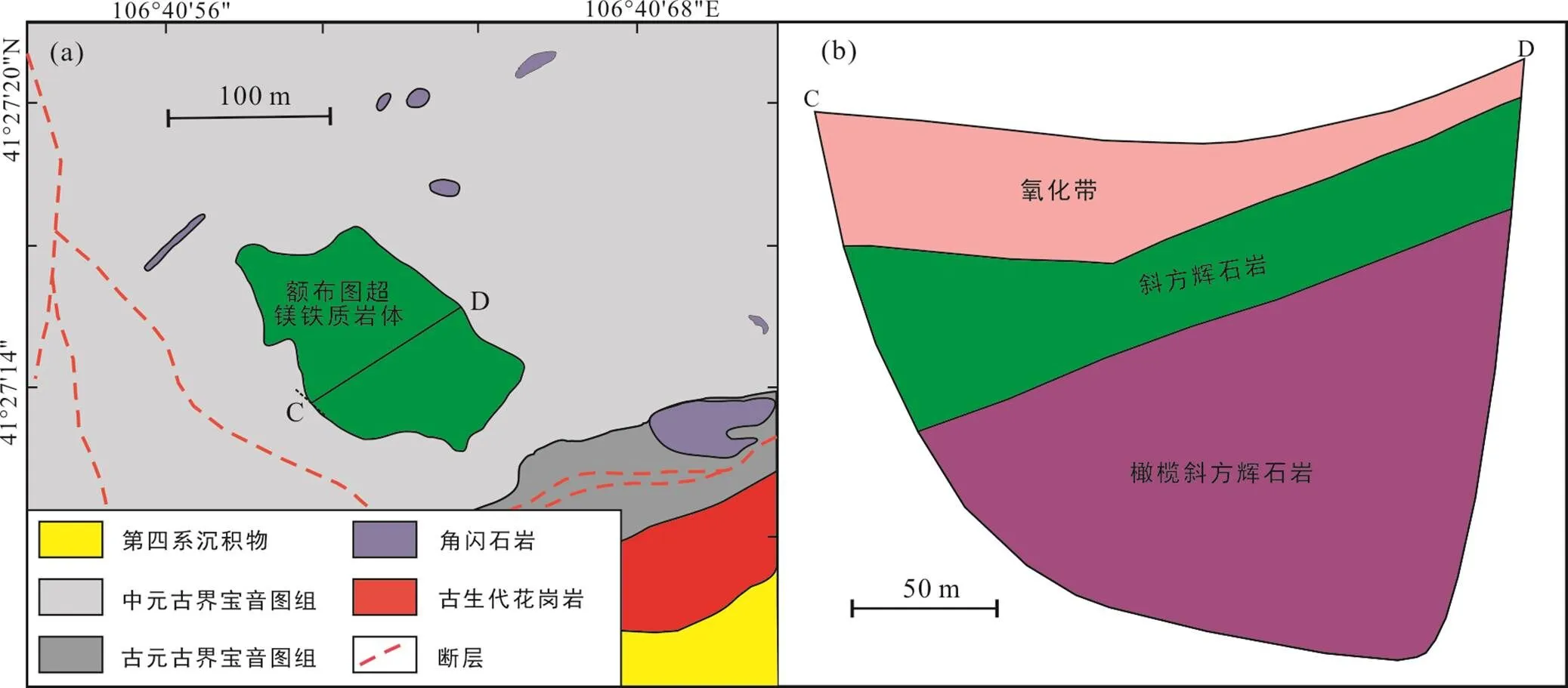
图2 额布图超镁铁质岩体及围岩地质简图(a)和额布图超镁铁质岩体剖面图(b, 据Peng et al., 2013)

矿物代号: Ol. 橄榄石; Opx. 斜方辉石; Cpy. 黄铜矿; Pn. 镍黄铁矿; Po. 磁黄铁矿; Sul. 硫化物。
橄榄斜方辉石岩主要由斜方辉石(~75%)、橄榄石(~15%)、单斜辉石(<10%)和少量角闪石组成。斜方辉石粒径可达2~3 mm。橄榄石呈粒状或浑圆状, 粒度介于0.2~1 mm之间。被斜方辉石和单斜辉石包裹的橄榄石的粒度多小于0.3 mm。沿橄榄石的裂理发育强烈蛇纹石化。单斜辉石呈它形粒状, 粒径介于0.4~0.5 mm之间, 边部具轻微蚀变。角闪石呈它形, 充填于两种辉石和橄榄石粒间(图4b)。
3 分析方法
选取斜方辉石岩和橄榄斜方辉石岩样品进行光薄片磨制和观察, 并挑选相对新鲜的岩石样品进行碎样, 选用刚玉破碎机对样品进行粗碎, 粗碎后用玛瑙球状研磨机磨至200目左右, 以供全岩分析。
3.1 全岩主量元素分析
全岩主量元素分析在澳实分析检测(广州)有限公司利用X射线荧光光谱法(XRF)完成。仪器型号为PANalytical Axios型XRF光谱仪, 分析精度优于5%。分析时所采用的标样为GBM306-12、GBM315-13、NCSDC73303和OREAS 195。
3.2 橄榄石成分分析
选择样品中相对新鲜的橄榄石颗粒进行主、微量元素分析, 测试分析在中国科学院矿物学与成矿学重点实验室完成。主量元素分析采用JEOL JXA-8230型电子探针(EPMA), 束斑直径1 μm, 加速电压15 kV, 电流20 nA。分析Mg、Fe和Si时, 分析时间为20 s, 背景分析时间为10 s; 分析Ca时, 分析时间为40 s, 背景分析时间为20 s; 分析Ni和Mn时, 分析时间为60 s, 背景分析时间为30 s。分析Mg、Si采用TAP晶体; 分析Fe、Mn和Ni采用 LIF晶体; 分析Ca采用PET晶体。使用的标样包括橄榄石(Si、Mg)、磁铁矿(Fe)、透辉石(Ca)、菱锰矿(Mn)和镍金属(Ni)。分析元素的检出限普遍<100 μg/g, 不需要波峰重叠校正。分析结果利用ZAF校正程序进行了修正。
橄榄石微量元素分析采用Resonetic RESOlution S-155激光器结合 Agilent 7900质谱联机的激光剥蚀电感耦合等离子体质谱仪(LA-ICP-MS)。激光剥蚀束斑直径为43 μm, 频率6 Hz, 以氦气为载气, 氩气为补偿气来调节灵敏度, 背景分析时间为20 s, 数据采集时间为50 s。分别采用NIST SRM 610和GOR-132为外标和监控标样。最后以电子探针得到的橄榄石的Si含量为内标利用ICPMS-DataCal 软件(Liu et al., 2008)对原始数据进行校正。大多数微量元素检出限小于 0.1 μg/g, 分析精度优于10%。
4 分析结果
4.1 全岩主量元素组成
额布图岩体全岩主量元素组成见表1。橄榄斜方辉石岩样品的烧失量(LOI)均>4.0%, 因此, 全岩成分均被校正至100%硅酸盐总量。在全岩的MgO与其他主量元素的二元图解上, 橄榄斜方辉石岩相比斜方辉石岩, 具有较高的MgO和FeOT(FeOT= Fe2O3T´0.89)含量、较低的SiO2和Al2O3含量, 以及相似的CaO含量(图5)。
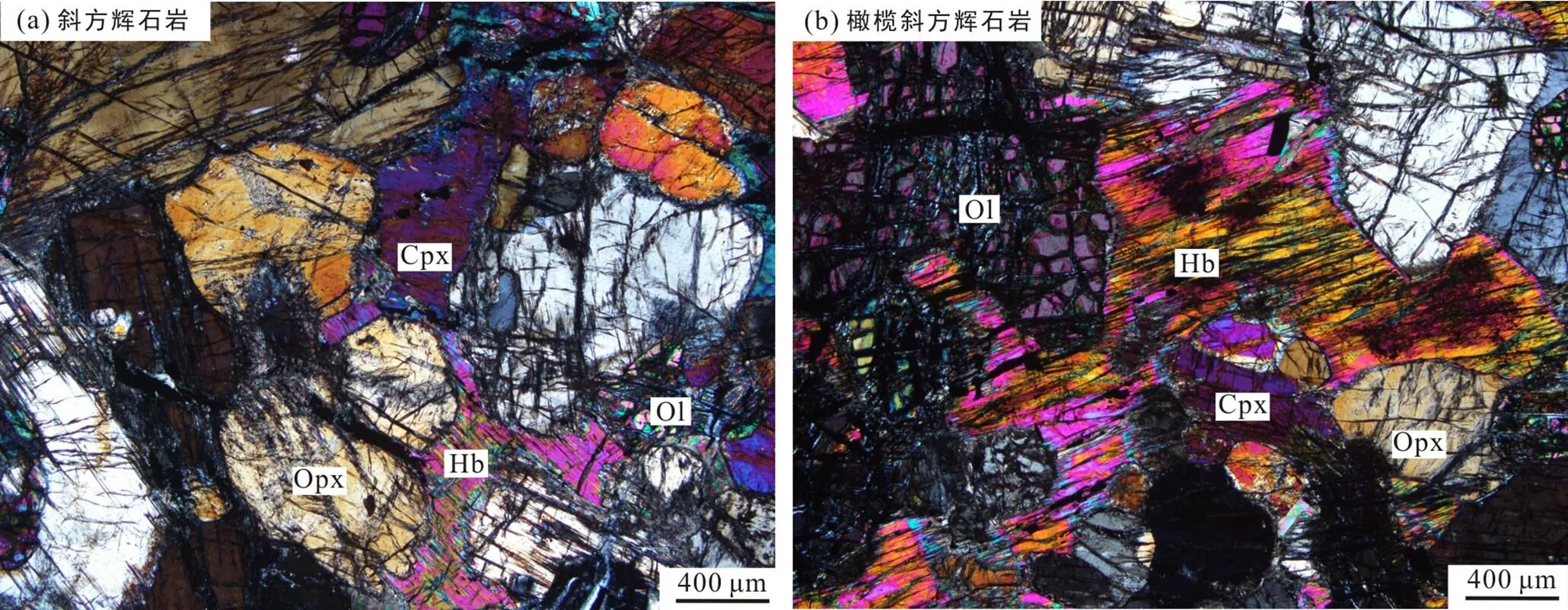
(a) 斜方辉石岩由大小不一的斜方辉石堆晶组成, 含少量橄榄石、单斜辉和角闪石; (b) 橄榄斜方辉石岩主要由斜方辉石和橄榄石组成, 岩石具包橄结构即橄榄石被包裹在斜方辉石。矿物代号: Ol. 橄榄石; Opx. 斜方辉石; Cpx. 单斜辉石; Hb. 角闪石。
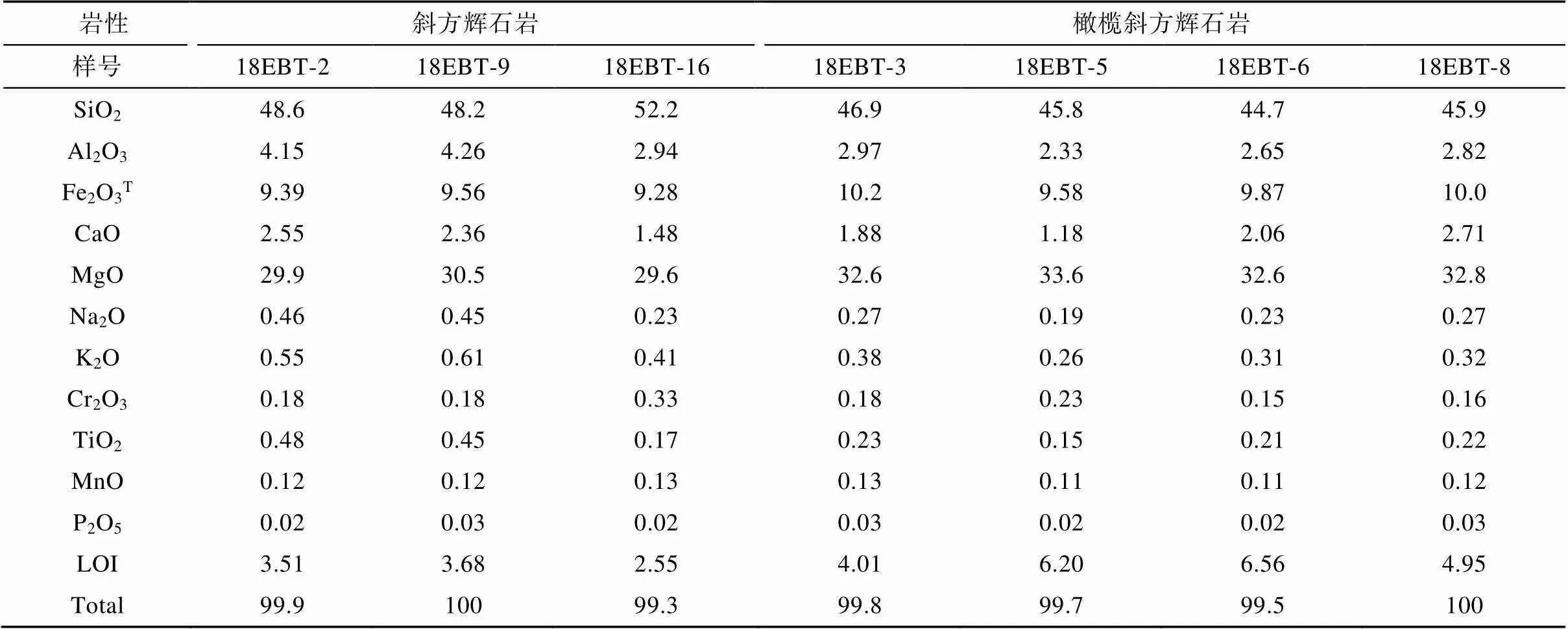
表1 额布图岩体的岩石主量元素组成(%)
两种岩石都表现出随MgO含量降低, FeOT含量逐渐降低, 而SiO2和Al2O3含量逐渐升高的趋势, CaO含量变化不明显。样品的全岩氧化物含量多落在斜方辉石端元附近, 表明额布图岩体两种岩性岩石的矿物组成主要为斜方辉石, 其次为橄榄石和单斜辉石。Peng et al. (2013)样品的全岩FeOT含量明显高于本次研究的样品, 样品的Cu含量(117~1249 μg/g)也远高于本次样品的Cu含量(36~304 μg/g, 课题组未发表数据)。考虑到Cu与S之间的正相关关系(图6), 表明Peng et al. (2013)的样品含有更多的硫化物, 而硫化物可以提供一定量的Fe2+。因此, 样品中FeOT含量的差别可能与其中硫化物的含量不同有关。
4.2 橄榄石的主量和微量元素组成
额布图岩体橄榄石的Fo值介于83~87之间(表2), 其Fo值与Ni含量之间无明显相关性。Fo<85的橄榄石与Fo>85的橄榄石具有明显不同的Ni含量: Fo>85橄榄石的Ni含量与洋中脊玄武岩(MORB)中橄榄石斑晶的Ni含量范围基本一致, 而Fo<85橄榄石的Ni含量则明显偏高, 与夏威夷Koolau玄武岩中橄榄石斑晶的Ni含量类似(图7a)。Fo>85橄榄石的Co含量与Fo值之间呈正相关关系, 而Fo<85橄榄石的Co含量与Fo值之间呈负相关关系(图7b)。橄榄石的Mn和Zn含量总体与Fo值之间呈明显的负相关关系(图7c、d), 与岩浆结晶分异的趋势一致, 但其Mn含量明显低于MORB和Koolau玄武岩中橄榄石斑晶的Mn含量。橄榄石的Ca含量普遍<1000 μg/g,与Duke Island杂岩体中橄榄石的Ca含量类似(Li et al., 2011), 远低于MORB及洋岛玄武岩(OIB)中橄榄石斑晶的Ca含量(>1500 μg/g, Foley et al., 2013)(图7e)。而额布图岩体中橄榄石的Ca含量大致与Fo值呈负相关关系(图6e), 这可能与岩体形成过程中仅有少量的单斜辉石结晶分异有关。额布图岩体中橄榄石的Li含量普遍高于5 μg/g, 略高于板内岩浆岩中橄榄石的Li含量(≤ 5 μg/g, Foley et al., 2013) (图7f)。
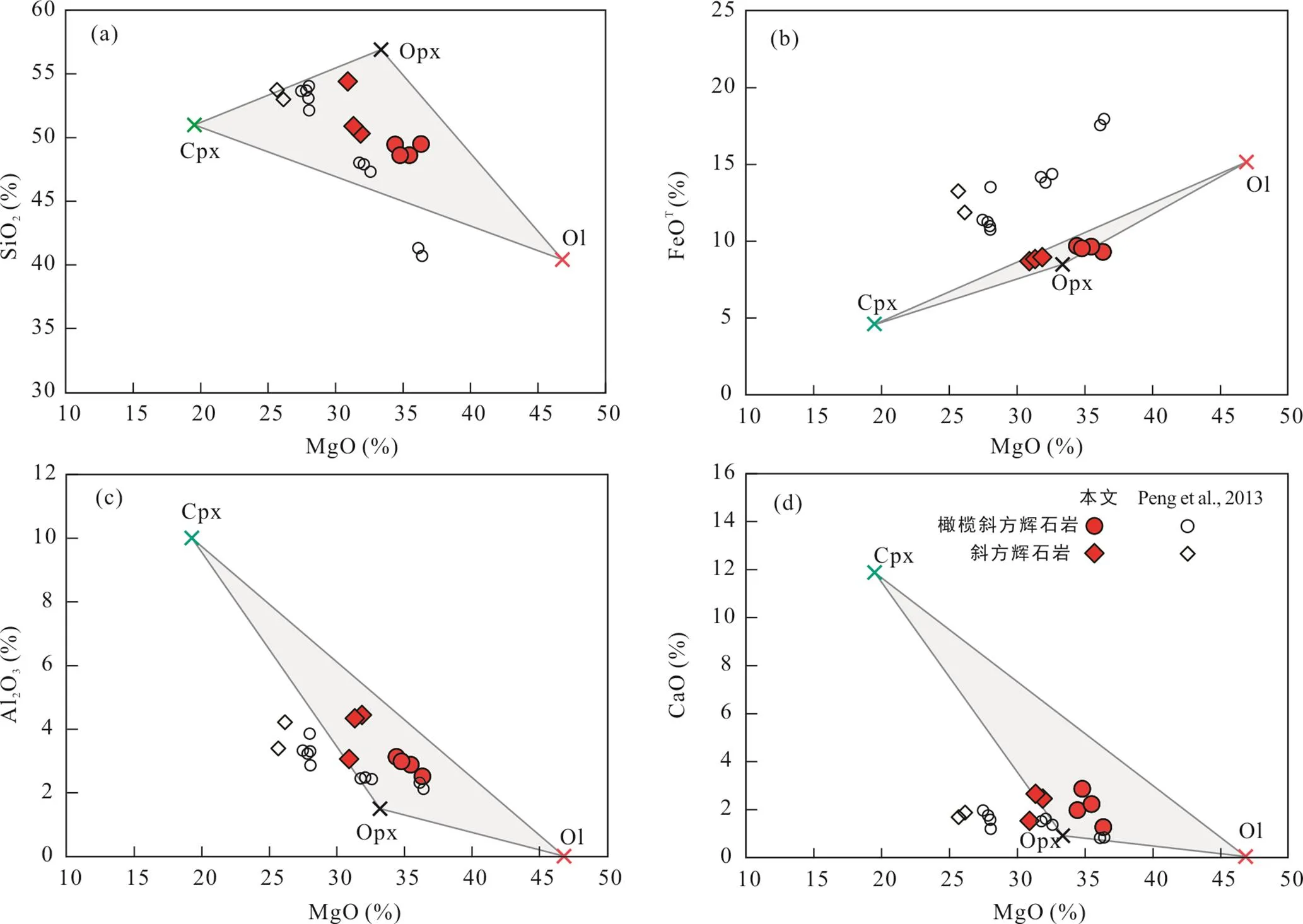
图中橄榄石(Ol)、斜方辉石(Opx)和单斜辉石(Cpx)的成分范围是矿物的电子探针分析结果。
5 讨 论
5.1 橄榄石Ni和Co含量对岩浆体系中硫化物饱和过程的指示
Ni和Co同为亲铁元素, 在橄榄石中均为相容元素, 橄榄石‒硅酸盐熔体之间的Ni分配系数(NiOl-Liq)为7.37~11.9(Wang and Gaetani, 2008), Co分配系数(CoOl-Liq)为2.48±0.68(Laubier et al., 2014)。二者又同为亲铜元素, 极易进入硫化物中, 硫化物‒硅酸盐熔体之间Ni的分配系数(NiSul-Liq)为300~1000(Patten et al., 2013), Co分配系数(CoSul-Liq)为20~580(Li and Audétat, 2012; Kiseeva and Wood, 2015), 均远远高于其在橄榄石‒硅酸盐熔体间的分配系数。在硫不饱和的岩浆体系中, 随着橄榄石结晶, 岩浆的Ni和Co含量均逐渐降低, 同时,NiOl-Liq及CoOl-Liq均逐渐升高, 但由于NiOl-Liq>CoOl-Liq,岩浆中Ni含量的下降幅度高于Co。因此, 随着岩浆分离结晶作用的进行, 从硫不饱和岩浆中结晶的橄榄石, 其Ni含量与Fo值呈正相关关系, 但Co含量与Fo值则可能呈负相关关系(Papike et al., 1999; Herd et al., 2009)。当岩浆体系达到硫化物饱和时, Ni和Co则优先进入硫化物熔体, 导致与硫化物熔体同时结晶的橄榄石的Ni和Co含量明显降低。在亚固相阶段, 硫化物熔体与橄榄石之间还可能发生Fe-Ni交换, 造成橄榄石的Ni含量与Fe含量呈正相关, 而与Fo值之间呈负相关关系(Barnes and Naldrett, 1985; Li et al., 2007)。因此, 橄榄石的Ni和Co含量与Fo值的相关性可作为判别体系是否达到硫化物饱和的指标。
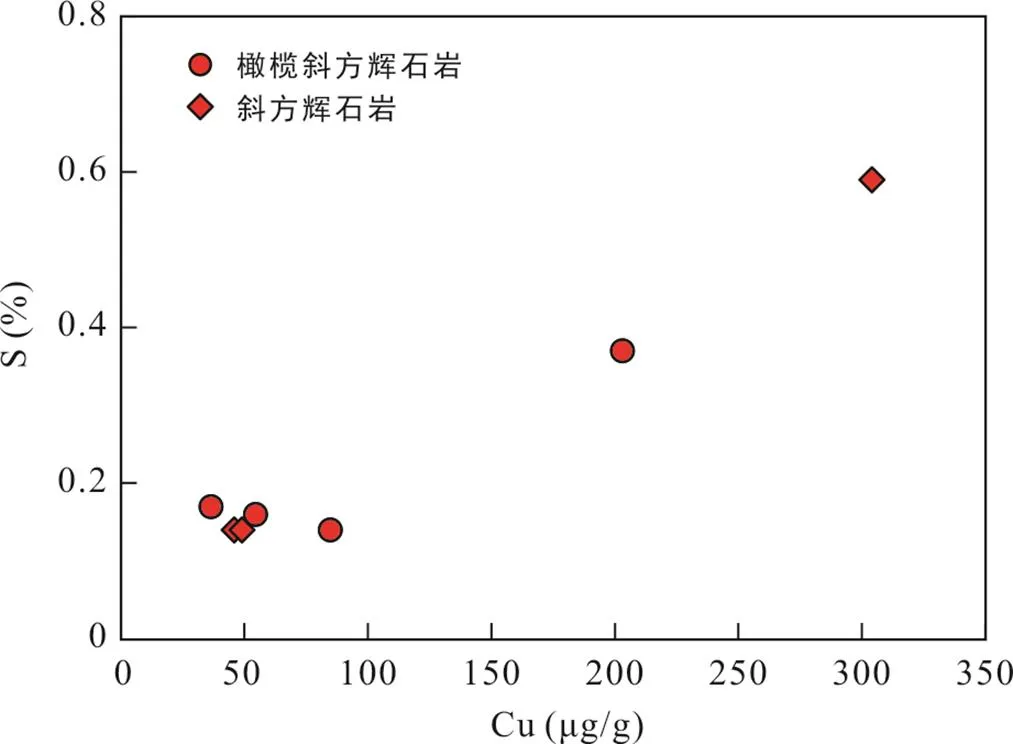
图6 额布图岩体的全岩S与Cu含量二元图解

表2 额布图岩体斜方辉石岩和橄榄斜方辉石岩中的橄榄石平均成分
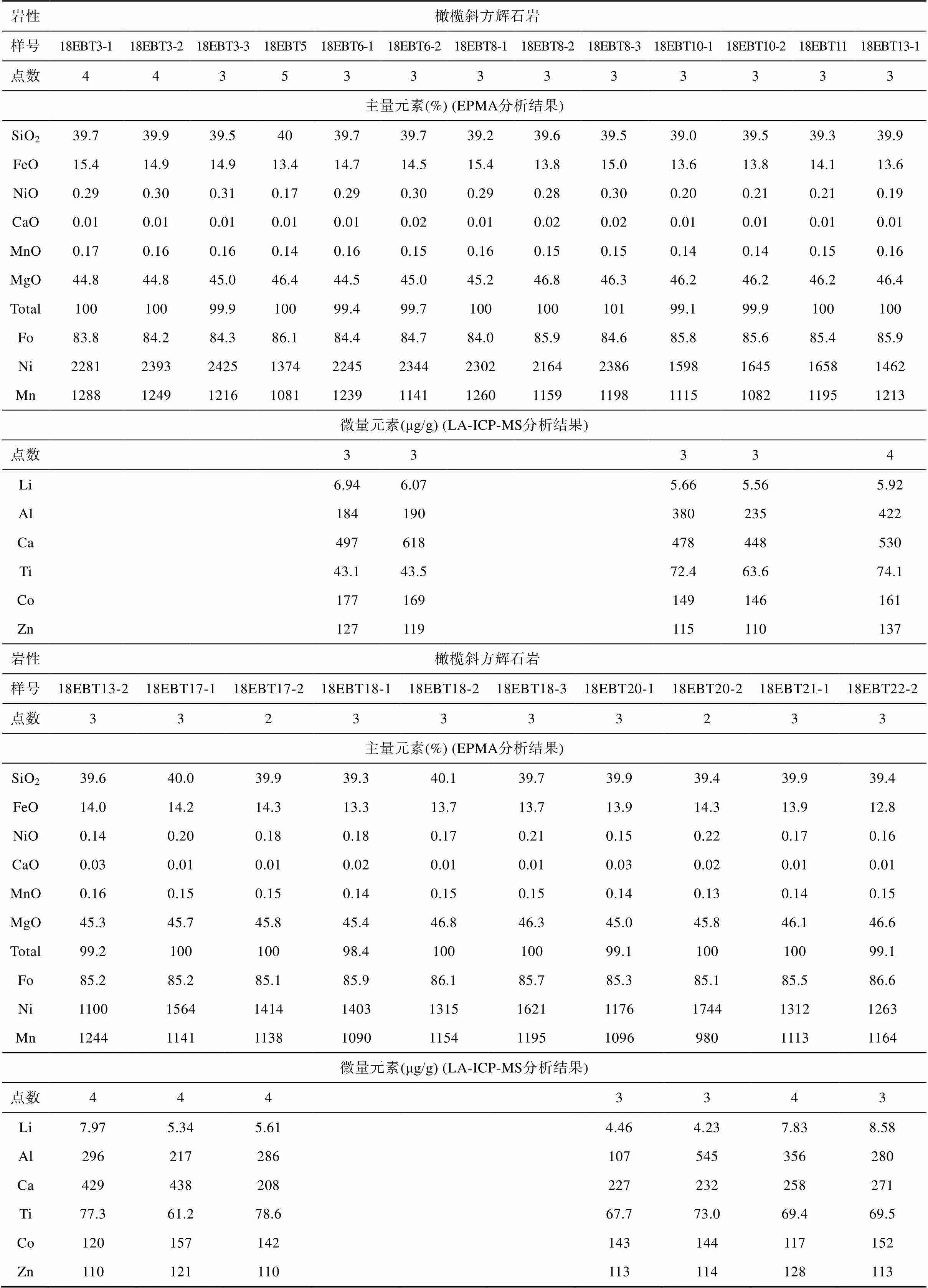
续表2:
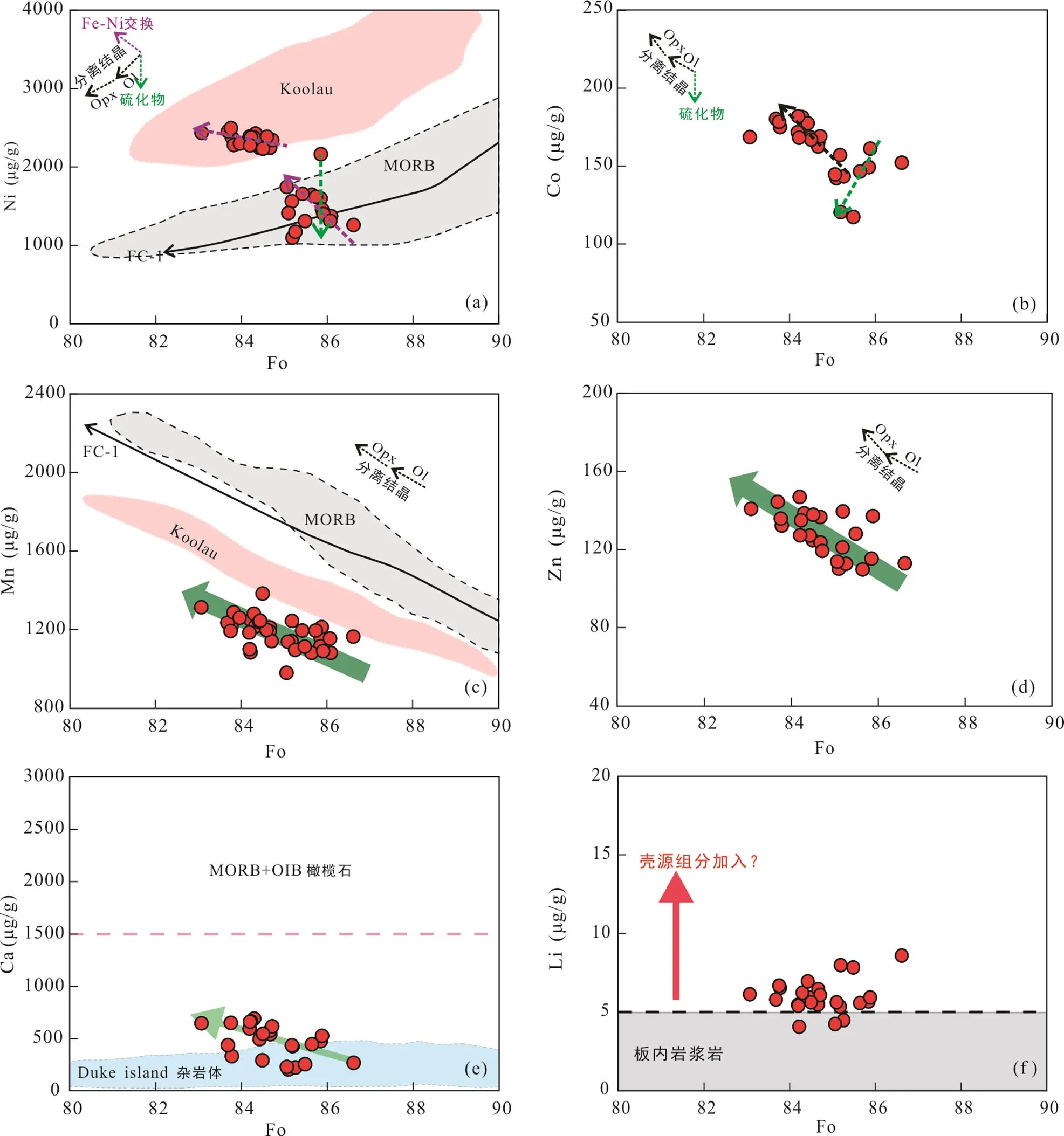
MORB. 全球范围内洋中脊玄武岩中的橄榄石斑晶成分(据Sobolev et al., 2007); Koolau. 夏威夷Koolau洋岛玄武岩中的橄榄石斑晶成分(据Sobolev et al., 2005); FC-1. 地幔橄榄岩来源熔体在3 GPa、1515 ℃和QFM条件下, 20%分离结晶过程中橄榄石成分的变化趋势(据Sobolev et al., 2007)。MORB+OIB橄榄石的Ca含量和板内岩浆岩中橄榄石的Li含量据Foley et al. (2013); Duke island 杂岩体中橄榄石的成分据Li et al. (2011)。
额布图岩体Fo>85橄榄石的Ni含量明显低于Fo<85橄榄石的Ni含量, 在橄榄石Fo>85时其Co含量与Fo值呈正相关关系(图7a、b), 表明该岩浆体系在早期已达到了硫化物饱和, 即Ni和Co优先进入硫化物熔体中, 导致Fo>85橄榄石的Ni和Co含量明显降低。另一方面, Fo<85橄榄石的Ni含量与Fo值之间呈负相关关系, 表明橄榄石与硫化物熔体之间发生了Fe-Ni交换(Barnes and Naldrett, 1985; Li et al., 2007), 说明体系发生了硫化物熔离。因此, 额布图岩体中橄榄石的Ni含量受到了硫化物熔离的影响, 其Ni/Mg值不能用来探讨地幔源区的组成特征。而橄榄石的Mn和Zn含量主要受控于岩浆结晶分异过程, 基本不受体系硫化物饱和的影响, 因此可利用橄榄石的Mn、Zn含量和Mn/Zn值等对其源区性质进行判别。
5.2 橄榄石微量元素比值对源区辉石岩组分的甄别
前人模拟计算结果显示, 在Fo值相同时, MORB中橄榄石斑晶与从橄榄岩地幔3 GPa压力下部分熔融熔体中结晶的橄榄石具有类似的Mn含量, 均高于辉石岩地幔部分熔融熔体中结晶橄榄石的Mn含量(Sobolev et al., 2007; Herzberg, 2011)。额布图岩体中橄榄石的Mn含量明显低于MORB中橄榄石, 但接近于辉石岩地幔来源的Koolau玄武岩中橄榄石(图7c)。这表明, 额布图岩体的母岩浆可能不是橄榄岩地幔部分熔融的产物, 而更可能与辉石岩地幔部分熔融作用有关。
额布图岩体橄榄石的Mn/Zn值随Fo值降低基本保持不变, 说明该比值基本未受分离结晶作用的影响。该Mn/Zn值<13, 远低于来源于橄榄岩地幔的Baffin苦橄岩和Etendeka玄武岩中橄榄石斑晶的Mn/Zn值, 而与来源于辉石岩地幔的Mwenezi和Tuli玄武岩中橄榄石斑晶的Mn/Zn值一致(图8)。
橄榄石的Mn/Fe和Zn/Fe值可以近似代表其幔源岩浆的相应比值, 可用来判断其地幔源区的性质(Le Roux et al., 2010; Howarth and Harris, 2017)。额布图岩体中橄榄石的Mn/Fe和Zn/Fe值与Mwenezi和Tuli玄武岩中橄榄石斑晶的相应比值一致, 均位于从辉石岩地幔熔融产生的熔体中结晶橄榄石的相应比值区域(图9b), 也指示其地幔源区可能存在辉石岩组分。
选取额布图岩体中Fo值最高的橄榄石(Fo=86.6), 利用Sobolev et al. (2007)提出的公式计算了来自辉石岩地幔的熔体对额布图岩体母岩浆成分的贡献。
px=3.48−2.071×(100×Mn/Fe)
式中:px表示辉石岩地幔来源熔体的比例; Mn和Fe分别为橄榄石中两种元素的含量。橄榄岩地幔对应的px值为−0.2~0.2, 辉石岩地幔对应的px值为0.8~1.2(Sobolev et al., 2009)。计算结果为1.06, 表明额布图岩体的母岩浆可能几乎全部是辉石岩地幔部分熔融的产物。
5.3 橄榄石的Ca和Li含量对地幔交代过程的指示
通常认为, 橄榄石的Ca含量主要受温度、压力和熔体成分的控制(Jurewicz and Watson, 1988; O’Reilly et al., 1997; Libourel, 1999; De Hoog et al., 2010), 但这些因素不能完全解释MORB、OIB和大陆溢流玄武岩(CFB)中橄榄石斑晶的Ca含量范围相互重叠的现象(Gavrilenko and Herzberg, 2016)。越来越多的证据表明, 橄榄石的Ca含量可能还受到岩浆体系中水含量的控制, 岩浆的含水量越高, Ca则越不容易进入橄榄石中。例如, 从富水的岛弧岩浆中结晶的橄榄石相比从相对贫水的板内岩浆中结晶的橄榄石, 具有明显更低的Ca含量(Feig et al., 2006; Kamenetsky et al., 2006; Gavrilenko and Herzberg, 2016)。因此, 橄榄石的Ca含量可用来表征幔源岩浆的含水程度。额布图岩体中橄榄石的Ca含量远低于MORB和OIB中橄榄石斑晶的Ca含量, 与岛弧环境形成的Duke island 杂岩体中橄榄石的Ca含量接近(图7e), 表明额布图岩体的母岩浆含水量较高, 这与岩石中普遍发育含水矿物(如角闪石)(图4)的特征一致。
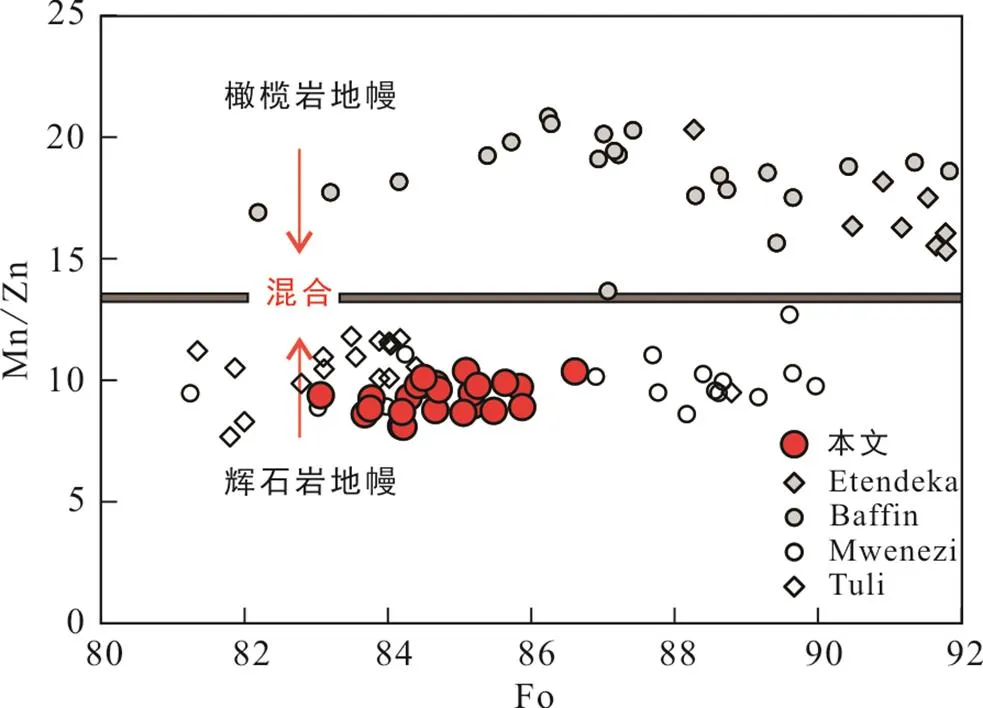
Etandeka玄武岩和Baffin苦橄岩来源于橄榄岩地幔, Mwenezi和Tuli玄武岩来源于辉石岩地幔。数据来源: Tuli, Mwenezi, Etendeka玄武岩中的橄榄石斑晶成分据Howarth and Harris (2017); Baffin苦橄岩中的橄榄石斑晶成分据De Hoog et al. (2010)。

橄榄岩地幔和辉石岩地幔参考范围分别引自Sobolev et al. (2007)和Howarth and Harris (2017)。
橄榄石‒硅酸盐熔体之间Li的分配行为基本不受温度控制, 橄榄石的Li含量主要与熔体成分有关(Brenan et al., 1998)。地幔橄榄岩的Li含量为1~2 μg/g (Seitz and Woodland, 2000), MORB的Li含量一般<4 μg/g(Tomascak et al., 2008; Marschall et al., 2017), 板内玄武岩中橄榄石斑晶的Li含量一般<5 μg/g (Jeffcoate et al., 2007; Chan et al., 2009; Foley et al., 2013)。但是, 在俯冲过程中, 板片脱水可将蚀变洋壳及大陆沉积物中的Li迁移至地幔楔, 造成地幔楔部分熔融产生的熔体中具有较高的Li含量(Chan and Kastner, 2000; Chan et al., 2002; Tomascak et al., 2002; Bouman et al., 2004; Tang et al., 2014)。额布图岩体橄榄石的Li含量明显高于板内岩浆岩中橄榄石的Li含量(图7f), 表明其地幔源区可能有俯冲板片组分的加入。
额布图岩体橄榄石总体具有低Ca、高Li的特征, 表明其地幔源区可能经历了俯冲板片来源熔体/流体的交代, 与Peng et al. (2013)认为该岩体形成于俯冲阶段的认识一致。而中亚造山带其他含矿岩体则主要形成在碰撞后伸展阶段, 初始岩浆中可能还具有来自软流圈地幔熔体的组分(Li et al., 2012; Mao et al., 2014)。
5.4 辉石岩地幔组分的成因
额布图岩体中锆石的Hf()值介于–8.5~–4.2之间(Peng et al., 2013), 全岩Nd()值介于–8~–5之间(课题组未发表数据), 其地幔源区具富集地幔特征, 与华北克拉通西部大陆下岩石圈地幔的特征基本一致(赵磊等, 2011; Guo et al., 2014; Pang et al., 2017)。前人通过对华北克拉通西部地幔包体和中‒新生代岩浆岩的地球化学研究, 证实华北克拉通西部大陆下岩石圈地幔曾遭受了明显的交代作用(Guo et al., 2014; Dai et al., 2018; Dai and Zheng, 2019)、并存在古老的下地壳组分(榴辉岩)(Guo et al., 2014)。本次研究认为, 当古亚洲洋向南俯冲至华北克拉通大陆下岩石圈地幔时, 俯冲板片释放的流体交代了上覆含有榴辉岩组分的地幔楔, 由于榴辉岩的固相线温度较低, 其优先熔融后产生的熔体与周围的地幔橄榄岩反应形成了辉石岩地幔组分。辉石岩地幔部分熔融产生的熔体形成了额布图岩体的母岩浆, 因此, 该岩体的岩石微量元素和同位素组成具有来自富集地幔岛弧岩浆的地球化学特征。
5.5 辉石岩地幔组分对铜镍硫化物矿床形成的贡献
幔源岩浆中的成矿金属元素含量(如Ni、Cu和PGE等)是能否形成岩浆铜镍硫化物矿床的重要因素之一, 其主要与地幔的部分熔融程度有关(Naldrett, 1989; Barnes and Lightfoot, 2005)。地幔高程度部分熔融不仅可以提高岩浆中成矿元素的含量, 而且可形成较大体积的岩浆量, 大量岩浆流经穿越地壳的岩浆通道/岩浆房时, 如果发生地壳混染, 则更有利于造成岩浆的硫化物饱和(Arndt et al., 2005; Barnes and Lightfoot, 2005)。因此, 绝大多数世界级铜镍硫化物矿床都与地幔柱引发的大规模岩浆作用有关(Pirajno, 2000; Ernst, 2007; Pirajno et al., 2009; Begg et al., 2010), 如Noril’sk, Bushveld, Voisey’s Bay, Jinchuan, Pechenga等(Barnes et al., 2001; Barnes and Lightfoot, 2005; Li et al., 2005; Naldrett, 2010)。然而, 额布图岩体形成于汇聚板块边缘环境, 其形成与俯冲作用有关。在俯冲环境产生的岩浆量无法与板内地幔柱活动或裂谷伸展环境产生的岩浆量相比, 但额布图岩体的地幔源区中含有大量的辉石岩组分。相比橄榄岩地幔, 辉石岩地幔部分熔融产生的熔体具有较高的Ni含量(Sobolev et al., 2005; Straub et al., 2008; Herzberg, 2011)。因此, 额布图岩体中发育的铜镍硫化物矿化说明, 在汇聚板块边缘发育的镁铁‒超镁铁质岩体, 如果其地幔源区含有辉石岩组分, 则地幔源区部分熔融产生的岩浆成矿元素含量有可能比较高, 有利于对铜镍硫化物矿化。
6 结 论
额布图岩体形成在汇聚板块边缘环境, 其地幔源区可能经历过俯冲板片来源流体的交代作用, 岩石中的橄榄石具有低Ca、高Li的特征。岩体的母岩浆可能是辉石岩地幔的部分熔融产物, 造成橄榄石具有较低的Mn含量和Mn/Fe值, 以及较高的Zn/Fe值。古亚洲洋板块向南俯冲至华北克拉通之下, 来自俯冲板块的流体和挥发分进入上覆地幔楔, 导致华北克拉通大陆下岩石圈地幔中的古老下地壳组分(榴辉岩)发生熔融、并与周围的地幔橄榄岩反应, 从而造成额布图岩体的地幔源区中含有大量的辉石岩组分。由于辉石岩地幔部分熔融产生的熔体具有较高的Ni含量, 造成了额布图岩体具有一定的铜镍硫化物矿化潜力。因此, 辉石岩地幔组分的存在, 对于汇聚板块边缘环境中镁铁‒超镁铁质岩浆的铜镍硫化物成矿作用是十分有利的。
中国科学院矿物学与成矿学重点实验室邢长明副研究员和吴丹老师在电子探针和LA-ICP-MS测试方面给予了指导和帮助; 中国科学院广州地球化学研究所黄小龙研究员和匿名审稿人对本文提出的宝贵意见和建议, 一并表示感谢。
党智财, 李俊健, 宋雪龙, 赵泽霖, 付超, 唐文龙. 2014. 内蒙古中部镁铁质‒超镁铁质岩带铜镍硫化物矿床地质特征. 地质找矿论丛, 29(3): 329–335.
江思宏, 聂凤军, 刘妍, 王新亮. 2003. 内蒙古小南山‒铂‒铜‒镍矿区辉长岩地球化学特征及成因. 地球学报, 24(2): 121–126.
李鹏, 任陪林, 白启星, 张淼鑫, 周南. 2013. 乌拉特中旗克布矿区镍矿床岩石学特征及成因浅析. 现代矿业, 53(6): 65–66.
李志丹, 王佳营, 文思博, 陈军强, 段明, 张锋, 魏佳林, 谢瑜. 2015. 内蒙古乌拉特中旗克布镍矿地质特征及超基性‒基性岩LA-ICP-MS锆石U-Pb年龄. 矿物学报, 35(1): 130–131.
吕林素, 毛景文, 周振华, 李宏博, 张作衡, 汪云峰. 2012.吉林红旗岭1号和7号岩体中含矿超镁铁质岩的矿物化学特征: 对岩浆演化过程以及铜镍硫化物矿床形成机制的约束. 岩石学报, 28(1): 319–344.
孙涛, 钱壮志, 汤中立, 姜常义, 何克, 孙亚莉, 王建中, 夏明哲. 2010. 新疆葫芦铜镍矿床锆石U-Pb年代学、铂族元素地球化学特征及其地质意义. 岩石学报, 26(11): 3339–3349.
赵磊, 吴泰然, 罗红玲. 2011. 内蒙古乌拉特中旗北七哥陶辉长岩SHRIMP锆石U-Pb年龄、地球化学特征及其地质意义. 岩石学报, 27(10): 3071–3082.
赵泽霖, 李俊建, 党智财, 付超, 唐文龙, 王守光, 刘利双, 赵丽君. 2016. 内蒙古黄花滩铜镍矿区辉长岩LA-ICP-MS锆石U-Pb定年及地球化学特征. 岩矿测试, 35(2): 208–216.
Arndt N, Lesher C M and Czamanske G K. 2005. Mantle-derivedmagmas and magmatic Ni-Cu-(PGE) deposits., 100th Aniversary Volume: 5–24.
Barnes S J and Lightfoot P C. 2005. Formation of magmatic nickel sulfide ore deposits and processes affecting their copper and platinum group element contents., 100th Anniversary Volume: 179–213.
Barnes S J, Melezhik V and Sokolov S. 2001. The composition and mode of formation of the pechenga nickel deposits, Kola Peninsula, Northwestern Russia., 39(2): 447–471.
Barnes S J and Naldrett A J. 1985. Geochemistry of the J-M (Howland) reef of the Stillwater complex, Minneapolis Adit area; I, Sulfide chemistry and sulfide-olivine equilibrium., 80(3): 627–645.
Begg G C, Hronsky J, Arndt N T, Griffin W L, O’reilly S Y and Hayward N H. 2010. Lithospheric, cratonic, and geodynamic setting of Ni-Cu-PGE sulfide deposits., 105(6): 1057–1070.
Bouman C, Elliott T and Vroon P Z. 2004. Lithium inputs to subduction zones., 212(1–2): 59–79.
Brenan J M, Neroda E, Lundstrom C C, Shaw H, Ryerson F and Phinney D L. 1998. Behaviour of boron, beryllium, and lithium during melting and crystallization: Constraintsfrom mineral-melt partitioning experiments — Inferences from10Be., 62(12): 2129–2141.
Chan L H, Alt J C and Teagle D A H. 2002. Lithium and lithium isotope profiles through the upper oceanic crust: A study of seawater-basalt exchange at ODP Sites 504B and 896A., 201(1): 187–201.
Chan L H and Kastner M. 2000. Lithium isotopic compositionsof pore fluids and sediments in the Costa Rica subduction zone: Implications for fluid processes and sediment contribution to the arc volcanoes., 183(1–2): 275–290.
Chan L H, Lassiter J C, Hauri E H, Hart S R and Blusztajn J. 2009. Lithium isotope systematics of lavas from the Cook-Austral Islands: Constraints on the origin of HIMU mantle., 277(3–4): 433–442.
Chen B, Jahn B M and Tian W. 2009. Evolution of the Solonker suture zone: Constraints from zircon U-Pb ages, Hf isotopic ratios and whole-rock Nd-Sr isotope compositions of subduction- and collision-related magmas and forearc sediments., 34(3): 245–257.
Dai H K and Zheng J P. 2019. Mantle xenoliths and host basalts record the Paleo-Asian oceanic materials in the mantle wedge beneath northwest North China Craton., 4(4): 150–158.
Dai H K, Zheng J P, Xiong Q, Su Y P, Pan S K, Ping X Q and Zhou X. 2018. Fertile lithospheric mantle underlyingancient continental crust beneath the northwestern North China craton: Significant effect from the southward subduction of the Paleo-Asian Ocean., 131(1–2): 3–20.
De Hoog J C M, Gall L and Cornell D H. 2010. Trace-elementgeochemistry of mantle olivine and application to mantlepetrogenesis and geothermobarometry., 270(1–4): 196–215.
Eizenhöfer P R, Zhao G C, Zhang J and Sun M. 2014. Final closure of the Paleo-Asian Ocean along the Solonker Suture Zone: Constraints from geochronological and geochemical data of Permian volcanic and sedimentary rocks., 33(4): 441–463.
Ernst R E. 2007. Large igneous provinces in Canada through time and their metallogenic potential., 5: 929–937.
Feig S T, Koepke J and Snow J E. 2006. Effect of water on tholeiitic basalt phase equilibria: An experimental study under oxidizing conditions., 152(5): 611–638.
Foley S F, Prelevic D, Rehfeldt T and Jacob D E. 2013. Minor and trace elements in olivines as probes into earlyigneous and mantle melting processes., 363(2): 181–191.
Gao J F and Zhou M F. 2013. Generation and evolution of siliceous high magnesium basaltic magmas in the formation of the Permian Huangshandong intrusion (Xinjiang, NW China)., 162–163(2): 128–139.
Gao S, Rudnick R L, Xu W L, Yuan H L, Liu Y S, Walker R J, Puchtel I S, Liu X, Huang H, Wang X R and Yang J. 2008. Recycling deep cratonic lithosphere and generation of intraplate magmatism in the North China Craton., 270(1–2): 41–53.
Gao S, Rudnick R L, Yuan H L, Liu X M, Liu Y S, Xu W L, Ling W L, Ayers J, Wang X C and Wang Q H. 2004. Recycling lower continental crust in the North China craton., 432(7019): 892–897.
Gavrilenko M and Herzberg C. 2016. A calcium-in-olivine geohygrometer and its application to subduction zone magmatism., 57(9): 1811–1832.
Guo P Y, Niu Y L, Ye L, Liu J J, Sun P, Cui H X, Zhang Y, Gao J P, Su L X, Zhao J X and Feng Y X. 2014. Lithosphere thinning beneath west North China Craton: Evidence from geochemical and Sr-Nd-Hf isotope compositions of Jining basalts., 202–203: 37–54.
Herd C D K, Dwarzski R E and Shearer C K. 2009. The behavior of Co and Ni in olivine in planetary basalts: An experimental investigation., 94(2–3): 244–255.
Herzberg C. 2011. Identification of source lithology in the Hawaiian and Canary islands: Implications for origins., 52(1): 113–146.
Herzberg C and Asimow P D. 2008. Petrology of some oceanic island basalts: PRIMELT2.XLS software for primary magma calculation.,,, 9(9): 1–25.
Hirschmann M M, Kogiso T, Baker M B and Stolper E M. 2003. Alkalic magmas generated by partial melting of garnet pyroxenite., 31(6): 481–484.
Hofmann A W. 2014. Sampling mantle heterogeneity through oceanic basalts: Isotopes and trace elements // Holland H D and Turekian K K. Treatise on Geochemistry, second edition. Oxford: Elsevier: 67–101.
Howarth G H and Harris C. 2017. Discriminating between pyroxenite and peridotite sources for continental flood basalts (CFB) in southern Africa using olivine chemistry., 475: 143–151.
Jahn B M. 2004. The Central Asian Orogenic Belt and growth of the continental crust in the Phanerozoic.,,, 226(1): 73–100.
Jeffcoate A B, Elliott T, Kasemann S A, Ionov D, Cooper K and Brooker R. 2007. Li isotope fractionation in peridotites and mafic melts., 71(1): 202–218.
Jian P, Liu D Y, Kröner A, Windley B F, Shi Y R, Zhang F Q, Shi G H, Miao L C, Zhang W, Zhang Q, Zhang L Q and Ren J S. 2008. Time scale of an early to mid-Paleozoic orogenic cycle of the long-lived Central Asian OrogenicBelt, Inner Mongolia of China: Implications for continental growth., 101(3): 233–259.
Jurewicz A J G and Watson E B. 1988. Cations in olivine, Part 1: Calcium partitioning and calcium-magnesium distribution between olivines and coexisting melts, with petrologic applications.,99(2): 176–185.
Kamenetsky V S, Elburg M, Arculus R and Thomas R. 2006. Magmatic origin of low-Ca olivine in subduction-relatedmagmas: Co-existence of contrasting magmas., 233(3–4): 346–357.
Kiseeva E S and Wood B J. 2015. The effects of composition and temperature on chalcophile and lithophile element partitioning into magmatic sulphides., 424(2015): 280–294.
Kogiso T, Hirschmann M M and Frost D J. 2003. High- pressure partial melting of garnet pyroxenite: Possible mafic lithologies in the source of ocean island basalts., 216(4): 603–617.
Laubier M, Grove T L and Langmuir C H. 2014. Trace elementmineral/melt partitioning for basaltic and basaltic andesitic melts: An experimental and laser ICP-MS study with application to the oxidation state of mantle source regions., 392(5): 265–278.
Le Roux V, Dasgupta R and Lee C T A. 2011. Mineralogical heterogeneities in the Earth’s mantle: Constraints from Mn, Co, Ni and Zn partitioning during partial melting., 307(3‒4): 395–408.
Le Roux V, Lee C T A and Turner S J. 2010. Zn/Fe systematicsin mafic and ultramafic systems: Implications for detecting major element heterogeneities in the Earth’s mantle., 74(9): 2779–2796.
Li C S, Naldrett A J and Ripley E M. 2007. Controls on the Fo and Ni contents of olivine in sulfide-bearing mafic- ultramafic intrusions: Principles, modeling, and examples from Voisey’s Bay., 14(5): 177– 183.
Li C S, Thakurta J and Ripley E M. 2011. Low-Ca contents and kink-banded textures are not unique to mantle olivine: Evidence from the Duke Island complex, Alaska., 104(3–4): 147–153.
Li C S, Zhang M J, Fu P E, Qian Z Z, Hu P Q and Ripley E M. 2012. The Kalatongke magmatic Ni-Cu deposits in the Central Asian Orogenic Belt, NW China: Product of slab window magmatism?, 47(1): 51–67.
Li X H, Su L, Chung S L, Li Z X, Liu Y, Song B and Liu D Y. 2005. Formation of the Jinchuan ultramafic intrusion and the world’s third largest Ni-Cu sulfide deposit: Associated with the ~825 Ma south China mantle plume?,,, 6(11): 1–16.
Li Y and Audétat A. 2012. Partitioning of V, Mn, Co, Ni, Cu, Zn, As, Mo, Ag, Sn, Sb, W, Au, Pb, and Bi between sulfide phases and hydrous basanite melt at upper mantle conditions., 355– 356: 327–340.
Libourel G. 1999. Systematics of calcium partitioning between olivine and silicate melt: Implications for melt structure and calcium content of magmatic olivines., 136(1): 63–80.
Liu Y S, Gao S, Lee C T A, Hu S, Liu X and Yuan H. 2005. Melt-peridotite interactions: Links between garnet pyroxenite and high-Mg#signature of continental crust., 234(1–2): 39–57.
Liu Y S, Hu Z, Gao S, Günther D, Xu J, Gao C and Chen H. 2008.analysis of major and trace elements of anhydrous minerals by LA-ICP-MS without applying an internal standard., 257(1–2): 34–43.
Mallik A and Dasgupta R. 2012. Reaction between MORB- eclogite derived melts and fertile peridotite and generation of ocean island basalts., 329–330: 97–108.
Mao Y J, Qin K Z, Li C, Xue S C and Ripley E M. 2014. Petrogenesis and ore genesis of the Permian Huangshanxi sulfide ore-bearing mafic-ultramafic intrusion in the Central Asian Orogenic Belt, western China., 200–201: 111–125.
Marschall H R, Wanless V D, Shimizu N, Pogge Von Strandmann P A E, Elliott T and Monteleone B D. 2017. The boron and lithium isotopic composition of mid-ocean ridge basalts and the mantle., 207: 102–138.
Naldrett A J. 1989. Magmatic Sulfide Deposits. Oxford: Oxford University Press: 1–728.
Naldrett A J. 2010. Secular Variation of magmatic sulfide deposits and their source magmas., 105(3): 669–688.
O’Reilly S. 1997. Minor elements in olivine from spinel lherzolite xenoliths: Implications for thermobarometry., 61(405): 257–269.
Pang C J, Wang X C, Xu B, Luo Z W and Liu Y Z. 2017. Hydrous parental magmas of Early to Middle Permian gabbroic intrusions in western Inner Mongolia, North China: New constraints on deep-Earth fluid cycling in the Central Asian Orogenic Belt., 144: 184–204.
Papike J J, Fowler G W, Adcock C T and Shearer C K. 1999. Systematics of Ni and Co in olivine from planetary melt systems: Lunar mare basalts., 84(3): 392–399.
Patten C, Barnes S J, Mathez E A and Jenner F E. 2013. Partition coefficients of chalcophile elements between sulfide and silicate melts and the early crystallization history of sulfide liquid: LA-ICP-MS analysis of MORB sulfide droplets., 358(6): 170–188.
Peng R M, Zhai Y S, Li C S and Ripley E M. 2013. The Erbutu Ni-Cu deposit in the Central Asian Orogenic Belt: A Permian magmatic sulfide deposit related to boninitic magmatism in an arc setting., 108(8): 1879–1888.
Pirajno F. 2000. Magmatic ore deposits // Ore Deposits and Mantle Plumes. Dordrecht, Netherland: Springer: 387–467.
Pirajno F, Ernst R E, Borisenko A S, Fedoseev G and Naumov E A. 2009. Intraplate magmatism in Central Asia and China and associated metallogeny., 35(2): 114–136.
Rapp R P, Shimizu N, Norman M D and Applegate G S. 1999. Reaction between slab-derived melts and peridotitein the mantle wedge: Experimental constraints at 3.8 GPa., 160(4): 335–356.
Seitz H M and Woodland A B. 2000. The distribution of lithium in peridotitic and pyroxenitic mantle lithologies —An indicator of magmatic and metasomatic processes., 166(1): 47–64.
Søager N, Portnyagin M, Hoernle K, Holm P M, Hauff F and Garbe-Schönberg D. 2015. Olivine major and trace element compositions in southern Payenia basalts, Argentina: Evidence for pyroxenite-peridotite melt mixing in a back-arc setting., 56(8): 1495–1518.
Sobolev A V, Hofmann A W, Kuzmin D, Yaxley G, Arndt N, Chung S L, Danyushevsky L, Elliott T, Frey F, Garcia M, Gurenko A, Kamenetsky V, Kerr A, Krivolutskaya N A K N, Matvienkov V, Nikogosian I, Rocholl A, Sigurdsson I, Sushchevskaya N and Teklay M. 2007. The amount of recycled crust in sources of mantle- derived melts., 316(5823): 412–417.
Sobolev A V, Hofmann A W, Sobolev S V and Nikogosian I K. 2005. An olivine-free mantle source of Hawaiian shield basalts., 434(7033): 590–597.
Sobolev A V, Krivolutskaya N A and Kuzmin D V. 2009. Petrology of the parental melts and mantle sources of Siberian trap magmatism., 17(3): 253–286.
Song X Y, Chen L M, Deng Y F and Xie W. 2013. Syncollisionaltholeiitic magmatism induced by asthenosphere upwelling owing to slab detachment at the southern margin of the central Asian Orogenic Belt., 170(6): 941–950.
Song X Y and Li X R. 2009. Geochemistry of the Kalatongke Ni-Cu-(PGE) sulfide deposit, NW China: Implications for the formation of magmatic sulfide mineralization in a postcollisional environment., 44(3): 303–327.
Song X Y, Xie W, Deng Y F, Crawford A J, Zheng W Q, Zhou G F, Deng G, Cheng S L and Li J. 2011. Slab break-off and the formation of Permian mafic-ultramaficintrusions in southern margin of Central Asian Orogenic Belt, Xinjiang, NW China., 127(1): 128–143.
Stracke A. 2012. Earth’s heterogeneous mantle: A product of convection-driven interaction between crust and mantle., 330–331: 274–299.
Straub S M, Lagatta A B, Martin-Del Pozzo A L and LangmuirC H. 2008. Evidence from high-Ni olivines for a hybridizedperidotite/pyroxenite source for orogenic andesites from the central Mexican Volcanic Belt.,,, 9(3): 1–33.
Sun T, Qian Z Z, Deng Y F, Li C S, Song X Y and Tang Q Y. 2013. PGE and isotope (Hf-Sr-Nd-Pb) constraints on the origin of the Huangshandong magmatic Ni-Cu sulfidedeposit in the Central Asian Orogenic Belt, northwestern China., 108(8): 1849–1864.
Tang D M, Qin K Z, Li C S, Qi L, Su B X and Qu W J. 2011. Zircon dating, Hf-Sr-Nd-Os isotopes and PGE geochemistry of the Tianyu sulfide-bearing mafic-ultramafic intrusion in the Central Asian Orogenic Belt, NW China., 126(1–2): 84–98.
Tang D M, Qin K Z, Su B X, Sakyi P A, Liu Y S, Mao Q, Santosh M and Ma Y G. 2013. Magma source and tectonics of the Xiangshanzhong mafic-ultramafic intrusion in the Central Asian Orogenic Belt, NW China, traced from geochemical and isotopic signatures., 170–171: 144–163.
Tang Y J, Zhang H F, Deloule E, Su B X, Ying J F, Santosh Mand Xiao Y. 2014. Abnormal lithium isotope composition from the ancient lithospheric mantle beneath the North China Craton., 4, 4274.
Tomascak P B, Langmuir C H, Le Roux P J and Shirey S B. 2008. Lithium isotopes in global mid-ocean ridge basalts., 72(6): 1626–1637.
Tomascak P B, Widom E, Benton L D, Goldstein S L and Ryan J G. 2002. The control of lithium budgets in island arcs., 196(3): 227–238.
Wang Z R and Gaetani G A. 2008. Partitioning of Ni between olivine and siliceous eclogite partial melt: Experimental constraints on the mantle source of Hawaiian basalts., 156(5): 661–678.
Wei B, Wang C Y, Li C S and Sun Y L. 2013. Origin of PGE-depleted Ni-Cu sulfide mineralization in the Triassic Hongqiling No.7 orthopyroxenite intrusion, Central Asian Orogenic Belt, Northeastern China., 108(8): 1813–1831.
Windley B F, Alexeiev D, Xiao W, Kröner A and Badarch G. 2007. Tectonic models for accretion of the Central Asian Orogenic Belt., 164(1): 31–47.
Xiao W J, Kröner A and Windley B. 2009. Geodynamic evolution of Central Asia in the Paleozoic and Mesozoic., 98(6): 1185– 1188.
Xiao W J, Pirajno F and Seltmann R. 2008. Geodynamics and metallogeny of the Altaid orogen., 32(2–4): 77–81.
Xiao W J, Windley B F, Hao J and Zhai M G. 2003. Accretion leading to collision and the Permian Solonker suture, Inner Mongolia, China: Termination of the central Asian orogenic belt., 22(6): 1–21.
Xie W, Song X Y, Deng Y F, Wang Y S, Ba D H, Zheng W Q and Li X B. 2012. Geochemistry and petrogenetic implications of a Late Devonian mafic-ultramafic intrusion at the southern margin of the Central Asian Orogenic Belt., 144–145: 209–230.
Yaxley G and Green D. 1998. Reactions between eclogite and peridotite: Mantle refertilisation by subduction of oceanic crust., 78(2): 243–255.
Zhou M F, Michael Lesher C, Yang Z X, Li J W and Sun M. 2004. Geochemistry and petrogenesis of 270 Ma Ni-Cu- PGE sulfide-bearing mafic intrusions in the Huangshan district, eastern Xinjiang, Northwest China: Implications for the tectonic evolution of the Central Asian orogenic belt., 209(3–4): 233–257.
Compositions of Olivine of Permian Erbutu Ultramafic Intrusion in the Central Asian Orogenic Belt (Inner Mongolia): Insights for the Pyroxenite Mantle Source
BAO Hongtian1, 2, WANG Christina Yan1, 3*, CAO Yonghua1and WEI Bo1, 3
(1.510640,; 2.100049,; 3.510640,)
The Erbutu ultramafic intrusion is located in the suture zone between the Central Asian Orogenic Belt and the northern margin of the North China Craton (NCC). The intrusion contains Ni-Cu sulfide mineralization. The intrusion is mainly composed of orthopyroxenite and olivine orthopyroxenite, both of which contain olivine that has Fo contents ranging from 83 to 87. At given Fo contents, the olivine in the rocks of the Erbutu intrusion has much lower Mn than that of the olivine crystallized from the magma derived from the peridotite mantle, indicating that the parental magma of the Erbutu intrusion was unlikely derived from a peridotite mantle. The olivine in the rocks of the Erbutu intrusion has Mn/Zn, Mn/Fe and Zn/Fe ratios similar to those of the olivine in the Mwenezi and Tuli basalts that were derived from typical pyroxenite mantle. Therefore, the Erbutu intrusion is likely derived from a pyroxenite dominated mantle source. The olivine in the rocks of the Erbutu intrusion contains lower Ca but higher Li than that of the olivine in igneous rocks in intra-plate settings, indicating that the mantle source of the intrusion may have been metasomatized by slab-derived fluids. It is proposed that during the subduction of the paleo-Asian oceanic slab beneath the northern margin of the NCC, slab-derived fluids were released and added to the mantle wedge and triggered melting of ancient lower crustal materials (., eclogite) in the mantle, the melt of the eclogite was then reacted with the ambient mantle peridotite and produced the pyroxenite component in the mantle.
olivine; pyroxenite mantle; Erbutu ultramafic intrusion; Central Asian Orogenic Belt
P595
A
1001-1552(2021)06-1185-017
10.16539/j.ddgzyckx.2021.06.005
2020-08-29;
2020-10-14
国家自然科学基金项目(41730423、41902077)资助。
暴宏天(1994–), 男, 博士研究生, 矿物学岩石学矿床学专业。Email: hongtian_b@outlook.com
王焰(1969–), 女, 研究员, 从事岩浆作用与成矿研究。Email: wang_yan@gig.ac.cn

